ISSN ONLINE(2319-8753)PRINT(2347-6710)
ISSN ONLINE(2319-8753)PRINT(2347-6710)
| K S Babulal, A.Pradeep and P.Muthukumar Assistant Professor, Department of Mechanical Engineering, Care Group of Institutions, Tiruchirappalli, TN, India |
| Related article at Pubmed, Scholar Google |
Visit for more related articles at International Journal of Innovative Research in Science, Engineering and Technology
The present study investigates the performance and emission analysis of Compression Ignition (C.I) engine fuelled with biodiesel and petroleum diesel fuel. The test is done with three fuels namely, petroleum diesel, biodiesel B40 and B100. The engine performance parameters like brake power (BP), brake specific fuel consumption (BSFC), brake thermal efficiency (BTE) and exhaust emission have been studied. BSFC for brake power 0.5 KW with petroleum diesel, B40 and B100 are 0.46 kg / kWh, 0.5 kg / kWh and 0.62 kg / kWh respectively. BTE at full load (3.75 kW) with petroleum diesel, B40 are close to 33 %, but BTE with B100 is about 28 %. NOx with B40 is increased about 2 % when compared to petroleum diesel, whereas with B100 is about 10 %. CO decreased about 20% with B40 and about 50 % with B100. The results conclude that biodiesel mixture of B40 can be the best substitute for petroleum diesel.
Keywords |
| Biodiesel, BP, BSFC, BTE, Exhaust Emission. |
INTRODUCTION |
| Biodiesel is composed of mono alkyl esters (methyl/ethyl esters), a long chain of fatty acids derived from renewable feedstock such as edible and non-edible vegetable oils, wasted frying oils and animal fats [1,2]. Biodiesel is oxygenated, sulphur free, non-toxic, bio gradable and renewable fuel. Diesel engines are the major application used in transportations, power plant generation, construction and industrial activities. These wide fields of the usage lead to increase the demand for petroleum fuel which is presently confronted with crises of reservations and concerns about environmental degradation. Worldwide, There has been renewed focus on biodiesel as a replacement for diesel fuel because it is biodegradable, nontoxic and can significantly reduce toxic emissions and overall life cycle emission of carbon dioxide (CO2) from the engine when burned as a fuel [3,4]. Biodiesel derived from vegetable oil and animal fats is being used in USA and Europe to reduce air pollution and dependence on fossil fuel. In USA and Europe, their surplus edible oils like soybean oil, sunflower oil and rapeseed oil are being used as feed stock for the production of biodiesel [5, 6]. |
| India is net importer of vegetable oils, it cannot be used for production of biodiesel. It has the potential to be a leading world producer of biodiesel, as it can be harvested and sourced from non-edible oils like Jatropha Curcas, Pongamia Pinnata, Neem ( Azadirachta indica), Mahua, castor, linseed, Kusum (Schleichera trijuga), etc. Some of these oils produced even now are not being properly utilized. Out of these plants, India is focusing on Jatropha Curcas and Pongamia Pinnata, which can grow in arid and wastelands. Oil content in the Jatropha and Pongamia seed is around 30- 40 %. India has about 80-100 million hectares of wasteland, which can be used for Jatropha and Pongamia plantation. India is one of the largest producers of Neem oil and its seed contains 30% oil content. It is an untapped source in India. Implementation of biodiesel in India will lead to many advantages like green cover to wasteland, support to agriculture and rural economy and reduction in dependence on imported crude oil and reduction in air pollution. These are the major advantages of the biodiesels to attract major researchers [7-9]. |
| Many research proved that the use of biodiesel results in a significant reduction in particulate matter (PM), hydrocarbons (HC) and carbon monoxide (CO) emissions; though it is observed a slight increase in nitrogen oxide (NOx) emission by most researchers when biodiesel is used [10-12]. Factor “B” used to state the amount of biodiesel in any fuel mix. Fuel containing 20% biodiesel is labelled as B20. Pure biodiesel is referred as B100. This present investigation aims at performance emission analysis of Single cylinder, 4 stroke, DI water cooled engine with pure petroleum diesel and its blend with biodiesel (B40, B100) as fuel. |
MATERIALS AND METHODS |
Materials |
| The material used to prepare biodiesel is pongamia oil. Fig.1. Shows the biodiesel reaction .All vegetable oils and animal fats consist primarily of triglyceride molecules.R1, R2, and R3 represent the hydrocarbon chains of the fatty acyl groups of the triglyceride. Transesterification is the process of reacting a triglyceride molecule with an excess of alcohol in the presence of a catalyst (KOH, NaOH, NaOCH3, etc.) to produce glycerol and biodiesel. |
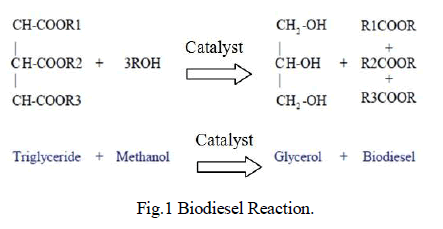 |
Methods |
| The basic flow chart of Biodiesel production is shown in Fig. 2. The mixture of pongamia oil, methanol and NAOH is stirred continuously and then allowed to settle under gravity in a separating funnel. Two distinct layers form after gravity settling for 24 hours. The upper layer is of ester and lower layer is of glycerol. The lower layer is separated out. The separated ester is mixed with some warm water (around 10 % volume of ester) to remove the catalyst present in ester and allowed to settle under gravity for another 24 hours. The catalyst gets dissolved in water, which is separated and removes the moisture. The methyl ester is then blended with mineral diesel in various concentrations for preparing biodiesel blends to be used in CI engine for conducting various engine tests. The engine used in this study is a kirloskar-diesel engine and its specification is given in Table 1. |
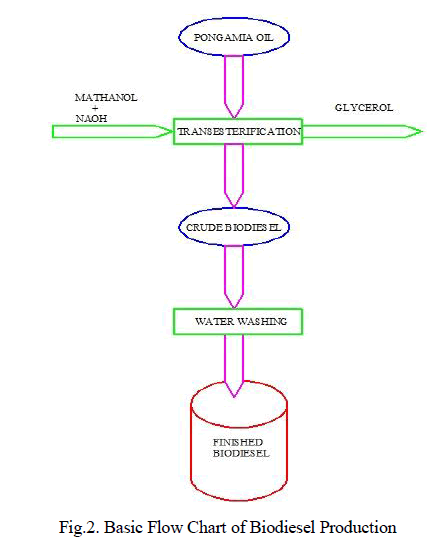 |
 |
RESULTS AND DISCUSSION |
Engine Performance |
| All experimental results are taken after 30 minutes of engine start, after which the exhaust line temperature become constant and there is almost no fluctuation of emissions. This condition of the engine is chosen because of the consistent data at this condition. The fuel consumption and emission measurements are taken at different engine loads. |
Brake Specific Fuel Consumption (BSFC) |
| The variation of Brake Specific Fuel Consumption (BSFC) of the engine with various fuels at different engine loads is shown in Fig.3. It is observed that BSFC decreases from initial load to a certain load condition and there after it increases for all fuels. For diesel the BSFC decreases from 0.46 kg/kWh at brake power 0.5 kW to 0.28 kg/kWh at brake power 2.5 kW, after which it approaches raise in BSFC. The BSFC with B40 decreases from 0.5 kg/kWh at brake power 0.5 kW to 0.29 kg/kWh at brake power 2.5 kW after which there is increase in BSFC. With B100, the BSFC decreases from 0.62 kg/kWh at brake power 0.5 kW to 0.32 kg/kWh at brake power 2.5 kW then after it approaches with increase in BSFC. It is calculated that, at low load condition, BSFC with B40 is about 8% and with B100 is about 35% higher than that of diesel. At full load condition, BSFC with B40 is about 3.5% and with B100 is about 14% higher than the diesel. This increase in BSFC is due to reduced calorific value and higher densities of the biodiesel blends. But in both load condition, it can be seen that B40 has less BSFC than B100. Therefore, B40 may be the best substitute for petroleum diesel with a little penalty in BSFC. |
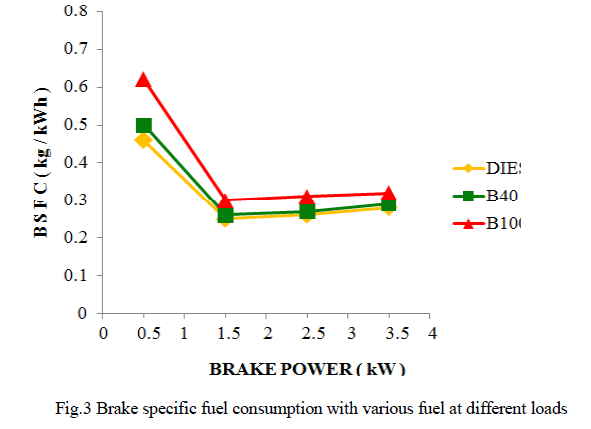 |
Brake Thermal Efficiency (BTE) |
| The variation of Brake Thermal Efficiency (BTE) of the engine with various fuels is shown in Fig. 4. The Brake Power (BP) increases from 0 to 3.75 kW and the BTE increases from 14 % at low load to 33 % at full load for petroleum diesel. B40 shows very similar full load efficiency to diesel, but low load efficiency is about 7 % lower. B100 shows 5% higher efficiency than diesel up to 50 % load. However, at full load condition B100 shows 15 % penalty in efficiency than diesel. Thus, B40 is recommended to use in diesel engine by compromising little penalty in efficiency at low load. |
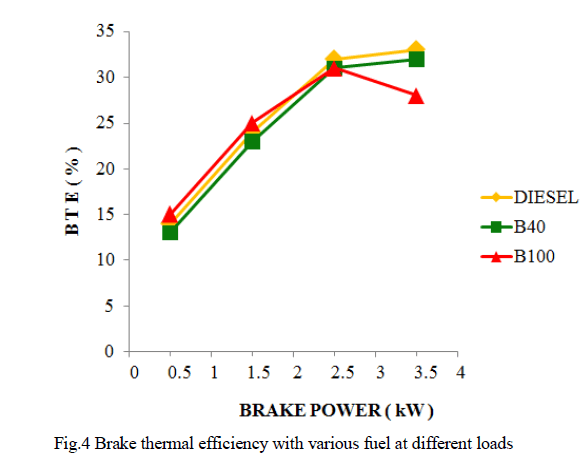 |
Engine Emissions |
NOX Emission |
| The NOx emission at different loads for various fuels is shown in Fig.5. NOx decreases with biodiesel and blend up to about 10 % load as compared to diesel. With further increase in load, NOx increases 1-4 % with B40 and 5-15 % with B100. Overall NOx increases with B40 about 2% and B100 with 10 %. As it is known, biodiesel fuels have oxygen content and thus, this leads to a better combustion. |
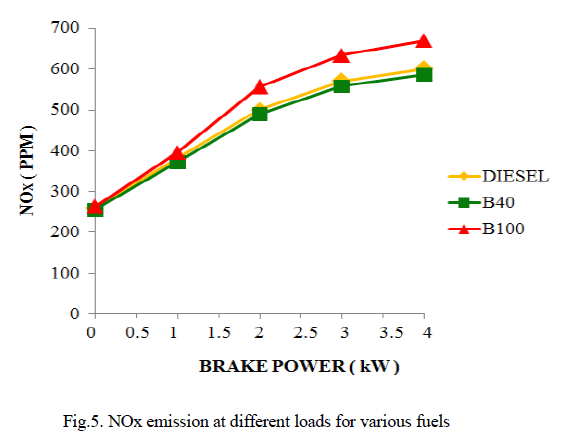 |
| This oxygen content of biodiesel is an important factor in the high NOx formation levels, because oxygen content of biodiesel provides high local peak temperatures and a corresponding excess of air. The maximum NOx emissions increase with increased mass percent of oxygen in the biofuel and increased engine speeds. Therefore, the higher NOx emissions can be attributed to the more complete combustion of the biodiesel with presence of more oxygen in the combustion chamber. |
CO Emission |
| CO emissions at different loads for various fuels are shown in Fig.6. CO decreases gradually from no load to about 75- 85 %, but increases to about double the ppm of its lowest value at full load condition. CO decreases about 20% with B40 and about 50 % with B100. |
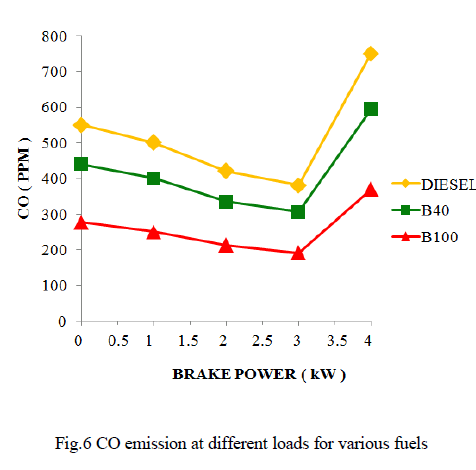 |
| Decrease in CO is due to the more complete combustion of biodiesel with presence of more oxygen in the combustion chamber. It is reported that due to the oxygenated nature of biodiesel, where more oxygen is available for burning, this fuel produces decreased rates of unburned hydrocarbon and CO emissions in the exhaust. |
CONCLUSION |
| The results obtained from the experimental investigation suggests the following conclusions, |
| 1. BSFC with B100 is about 26 % higher than diesel, whereas with B40 is 8 %.Hence B40 is preferable. |
| 2. At full load condition BTE for B40 is almost equal to diesel and hence B40 can be better alternative fuel for diesel. |
| 3. NOx emission at full load condition for B40 is only 2 % higher than diesel, whereas B100 is highest with 10 % .B40 showed about 20 % reduction in CO emission and B100 showed about 60% reduction in CO reduction. |
| 4. The results from BSFC, BTE and emission analysis indicates that B40 could the best substitute for petroleum diesel. |
References |
|